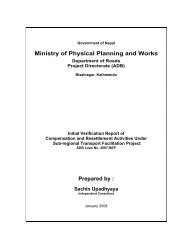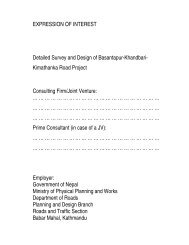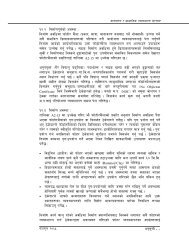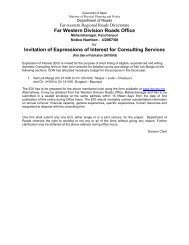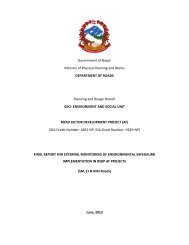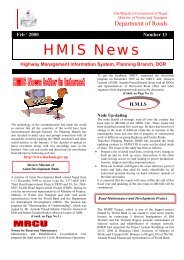Environmental & Social Management Framework - About ...
Environmental & Social Management Framework - About ...
Environmental & Social Management Framework - About ...
You also want an ePaper? Increase the reach of your titles
YUMPU automatically turns print PDFs into web optimized ePapers that Google loves.
<strong>Environmental</strong> and <strong>Social</strong> <strong>Management</strong> <strong>Framework</strong>how to subject the affected landowners in this corridor to relocation and/or furtheruse of their properties located in this corridor. It also needs to be appreciated thatthe proposal of acquiring a 30 m RoW corridor for rural areas where most peoplelive close to existing roads and tracks will substantially increase the overall costsfor upgrading or building new roads, apart from the expected magnitude ofresettling those people. In other words, rural road upgrading will then become amajor financial and social issue for the GoN. Other complications are foreseen inthe legal rights of local communities and land owners who wish to continue theircustomary land use of any land adjacent to the road formation line, be it foragriculture, plantations or other non-structure works and welfare purposes.Unless the policy directions regarding compulsory land acquisition for rural roaddevelopment are not resolved and clearly applicable throughout the country for allnational highways, this ESMF will adhere to the practical solution, i.e. consideringthe acquisition of a road formation RoW corridor only, and consider arecommendation to provide policy directions that would subject land owners fornot further erecting permanent structures in a pre-defined corridor (e.g. a RoW of15 to 30 m width) that will individually be adjusted by the project proponent (i.e.DoR and/or MoPPW).Notwithstanding, policies and legal provisions are needed to determine easementfees and payment for crop damages to land owners and entitled persons tocompensate those whose fields may be subject to periodic intrusion into a predefinedRoW for maintenance and operation purposes. Such provisions arenecessary to exclude claims regarded (temporary) restrictions on land use. At thesame time, legal provisions need to be created that regulate restrictions in thepre-defined RoW such as constructing new structures which may result indismantling for maintenance, operation and potential road widening, andpenalties for violators as per law.3.9.5 Policies of other Donor Agencies relating to Involuntary ResettlementIn recent years, a number of multilateral and bilateral agencies have preparedand adopted resettlement policies and guidelines that are similar to those of theWorld Bank and ADB. The Inter-American Development Bank adopted a set ofresettlement guidelines in 1990. In 1991, the Organization for EconomicCooperation and Development (OECD) approved the adoption of uniformresettlement guidelines by their countries’ aid agencies. The OverseasDevelopment Administration in the United Kingdom has adopted guidelines thatare essentially the same as those of the World Bank. The Overseas EconomicCooperation Fund of Japan issued checklists on involuntary resettlement basedon World Bank directives. Japan International Cooperation Agency (JICA) hasprepared its own technical guidelines for resettlement with World Bank advice.Chapter 3-22 April 2007



![j:6 ]zg cfof ]hgf](https://img.yumpu.com/51286794/1/190x245/j6-zg-cfof-hgf.jpg?quality=85)

![x'nfsL /fhdfu { cfof ]hgf](https://img.yumpu.com/50581959/1/190x245/xnfsl-fhdfu-cfof-hgf.jpg?quality=85)
